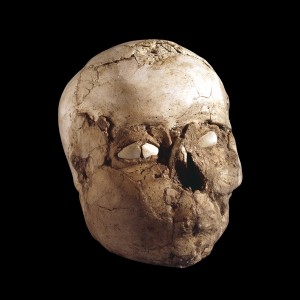
Plastered skull now in the collection of the British Museum, from Jericho, Israel, 7000-6000 BC. Photo credit: British Museum
Dr. Kroucher’s talk discussed the plastered skulls sometimes found in burials across the Near Eastern Neolithic, at sites including Ein Ghazal and Chatalhoyuk. Approximately 90 skulls have been recovered from across the Near East where the skull of an individual has been plastered over after death and decomposition. Some plastered skulls have shells or stones in place for eyes, and sometimes colourings such as browns or pinks were used probably to make the skull look more life-like. An absence of plaster on most skulls where hair would have been has led some researchers to suggest that wigs or hair may have been attached to the skulls. The reasons for some skulls being plastered and displayed are unclear and Dr. Kroucher’s research questions related to understanding the practice of skull-plastering and whether we can use contemporary theories of grief and mourning to inform on past mortuary practices.
